TOYOTA COROLLA HATCHBACK 2022 Owners Manual (in English)
Manufacturer: TOYOTA, Model Year: 2022, Model line: COROLLA HATCHBACK, Model: TOYOTA COROLLA HATCHBACK 2022Pages: 758, PDF Size: 155.26 MB
Page 111 of 758
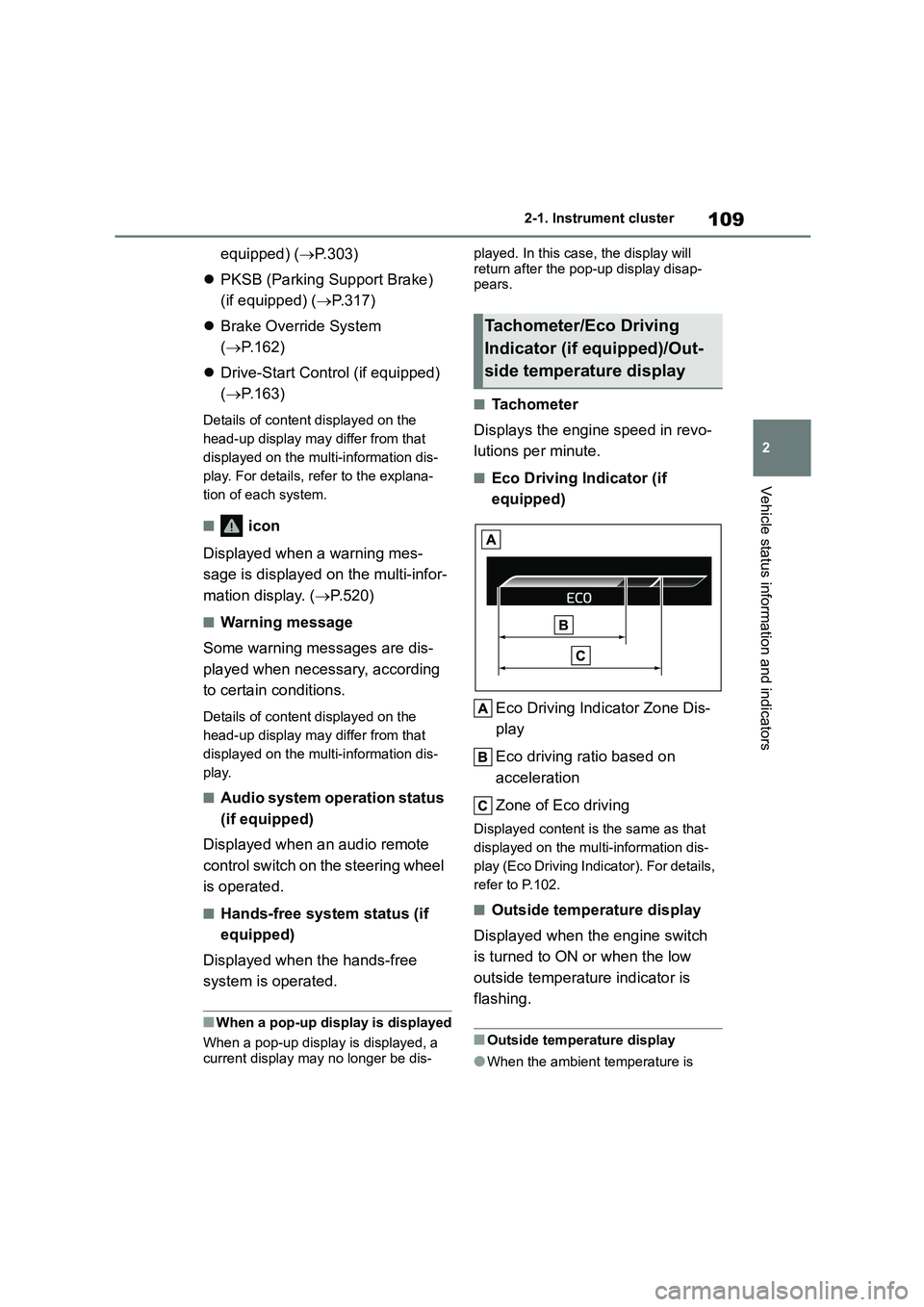
109
2
2-1. Instrument cluster
Vehicle status information and indicators
equipped) ( ’é«P.303)
’ü¼ PKSB (Parking Support Brake)
(if equipped) ( ’é«P.317)
’ü¼ Brake Override System
( ’é«P.162)
’ü¼ Drive-Start Control (if equipped)
( ’é«P.163)
Details of content displayed on the
head-up display may differ from that
displayed on the multi-information dis-
play. For details, refer to the explana-
tion of each system.
Ō¢Ā icon
Displayed when a warning mes-
sage is displayed on the multi-infor-
mation display. ( ’é«P.520)
Ō¢ĀWarning message
Some warning messages are dis-
played when necessary, according
to certain conditions.
Details of content displayed on the
head-up display may differ from that
displayed on the multi-information dis-
play.
Ō¢ĀAudio system operation status
(if equipped)
Displayed when an audio remote
control switch on the steering wheel
is operated.
Ō¢ĀHands-free system status (if
equipped)
Displayed when the hands-free
system is operated.
Ō¢ĀWhen a pop-up display is displayed
When a pop-up display is displayed, a
current display may no longer be dis-
played. In this case, the display will
return after the pop-up display disap- pears.
Ō¢ĀTachometer
Displays the engine speed in revo-
lutions per minute.
Ō¢ĀEco Driving Indicator (if
equipped)
Eco Driving Indicator Zone Dis-
play
Eco driving ratio based on
acceleration
Zone of Eco driving
Displayed cont ent is the same as that
displayed on the multi-information dis-
play (Eco Driving Indicator). For details,
refer to P.102.
Ō¢ĀOutside temperature display
Displayed when the engine switch
is turned to ON or when the low
outside temperature indicator is
flashing.
Ō¢ĀOutside temperature display
ŌŚÅWhen the ambient temperature is
Tachometer/Eco Driving
Indicator (if equipped)/Out-
side temperature display
Page 112 of 758
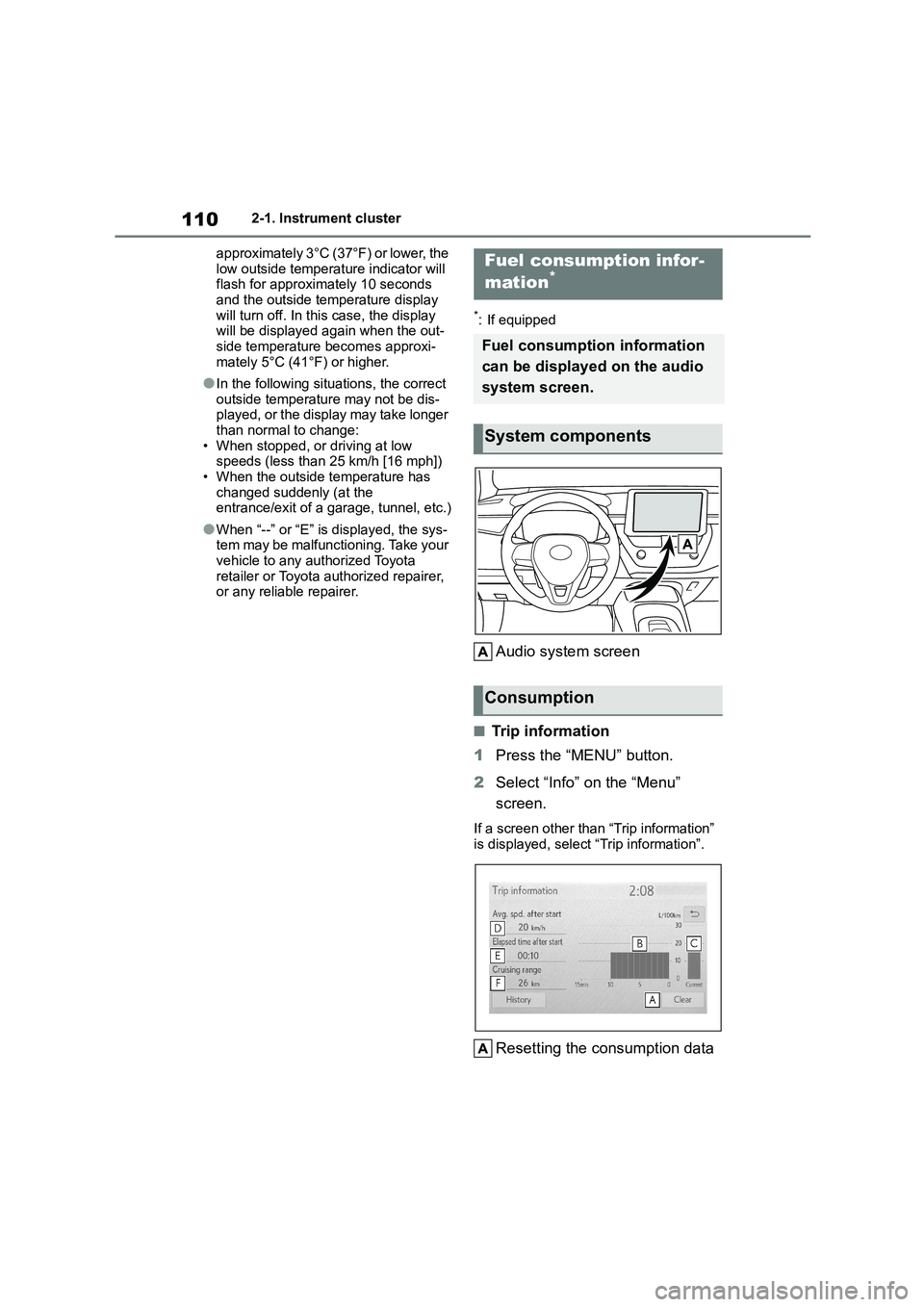
1102-1. Instrument cluster
approximately 3┬░C (37┬░F) or lower, the
low outside temperature indicator will flash for approximately 10 seconds
and the outside temperature display
will turn off. In this case, the display will be displayed again when the out-
side temperature becomes approxi-
mately 5┬░C (41┬░F) or higher.
ŌŚÅIn the following situations, the correct
outside temperature may not be dis- played, or the display may take longer
than normal to change:
ŌĆó When stopped, or driving at low speeds (less than 25 km/h [16 mph])
ŌĆó When the outside temperature has
changed suddenly (at the entrance/exit of a garage, tunnel, etc.)
ŌŚÅWhen ŌĆ£--ŌĆØ or ŌĆ£EŌĆØ is displayed, the sys-tem may be malfunctioning. Take your
vehicle to any authorized Toyota
retailer or Toyota authorized repairer, or any reliable repairer.
*: If equipped
Audio system screen
Ō¢ĀTrip information
1 Press the ŌĆ£MENUŌĆØ button.
2 Select ŌĆ£InfoŌĆØ on the ŌĆ£MenuŌĆØ
screen.
If a screen other than ŌĆ£Trip informationŌĆØ
is displayed, select ŌĆ£Trip informationŌĆØ.
Resetting the consumption data
Fuel consumption infor-
mation*
Fuel consumption information
can be displayed on the audio
system screen.
System components
Consumption
Page 113 of 758
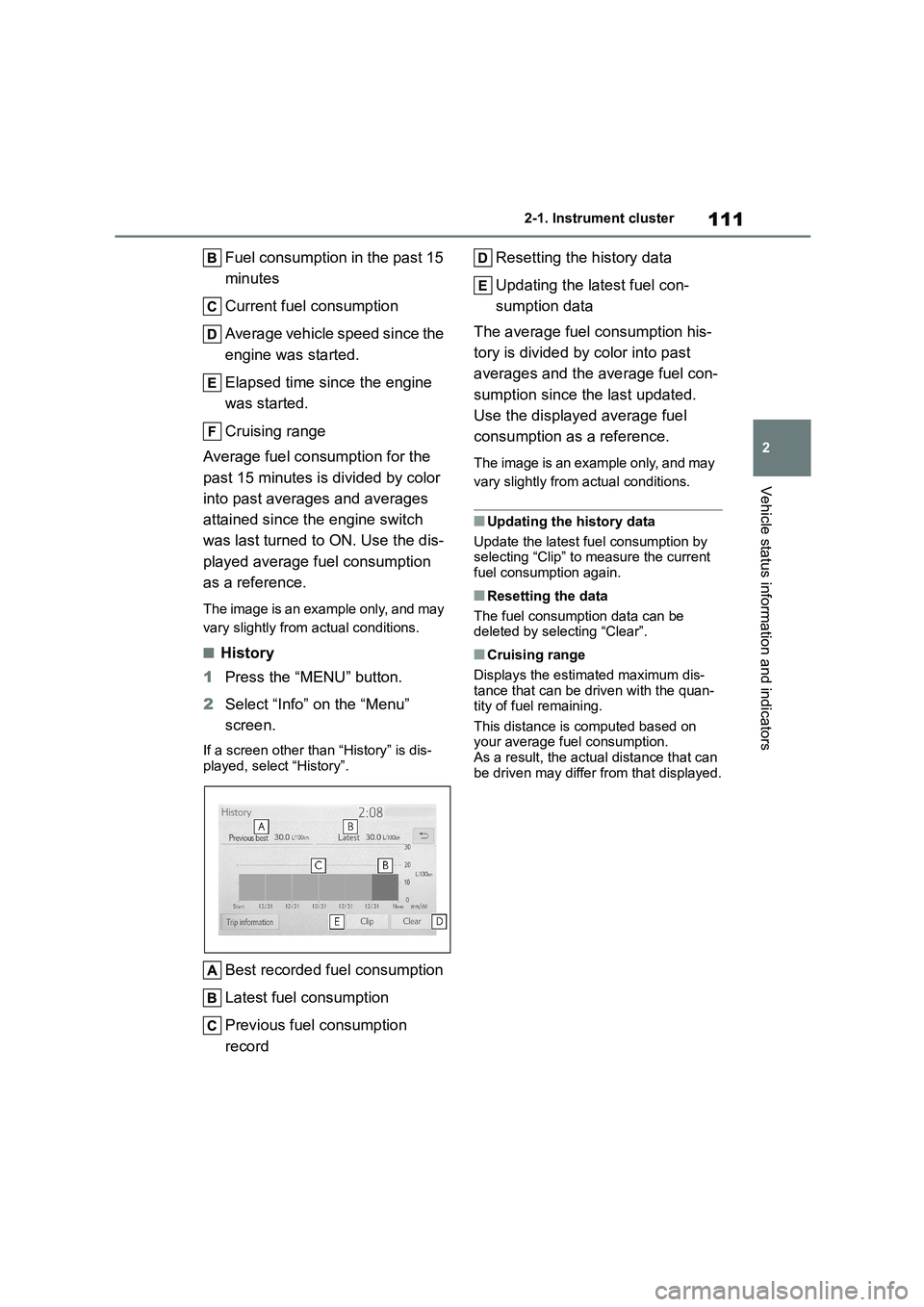
111
2
2-1. Instrument cluster
Vehicle status information and indicators
Fuel consumption in the past 15
minutes
Current fuel consumption
Average vehicle speed since the
engine was started.
Elapsed time since the engine
was started.
Cruising range
Average fuel consumption for the
past 15 minutes is divided by color
into past averages and averages
attained since the engine switch
was last turned to ON. Use the dis-
played average fuel consumption
as a reference.
The image is an example only, and may
vary slightly from actual conditions.
Ō¢ĀHistory
1 Press the ŌĆ£MENUŌĆØ button.
2 Select ŌĆ£InfoŌĆØ on the ŌĆ£MenuŌĆØ
screen.
If a screen other than ŌĆ£HistoryŌĆØ is dis-
played, select ŌĆ£HistoryŌĆØ.
Best recorded fuel consumption
Latest fuel consumption
Previous fuel consumption
record
Resetting the history data
Updating the latest fuel con-
sumption data
The average fuel consumption his-
tory is divided by color into past
averages and the average fuel con-
sumption since the last updated.
Use the displayed average fuel
consumption as a reference.
The image is an example only, and may
vary slightly from actual conditions.
Ō¢ĀUpdating the history data
Update the latest fuel consumption by
selecting ŌĆ£ClipŌĆØ to measure the current
fuel consumption again.
Ō¢ĀResetting the data
The fuel consumption data can be deleted by selecting ŌĆ£ClearŌĆØ.
Ō¢ĀCruising range
Displays the estimated maximum dis-
tance that can be driven with the quan- tity of fuel remaining.
This distance is computed based on
your average fuel consumption. As a result, the actual distance that can
be driven may differ from that displayed.
Page 114 of 758

1122-1. Instrument cluster
Page 115 of 758
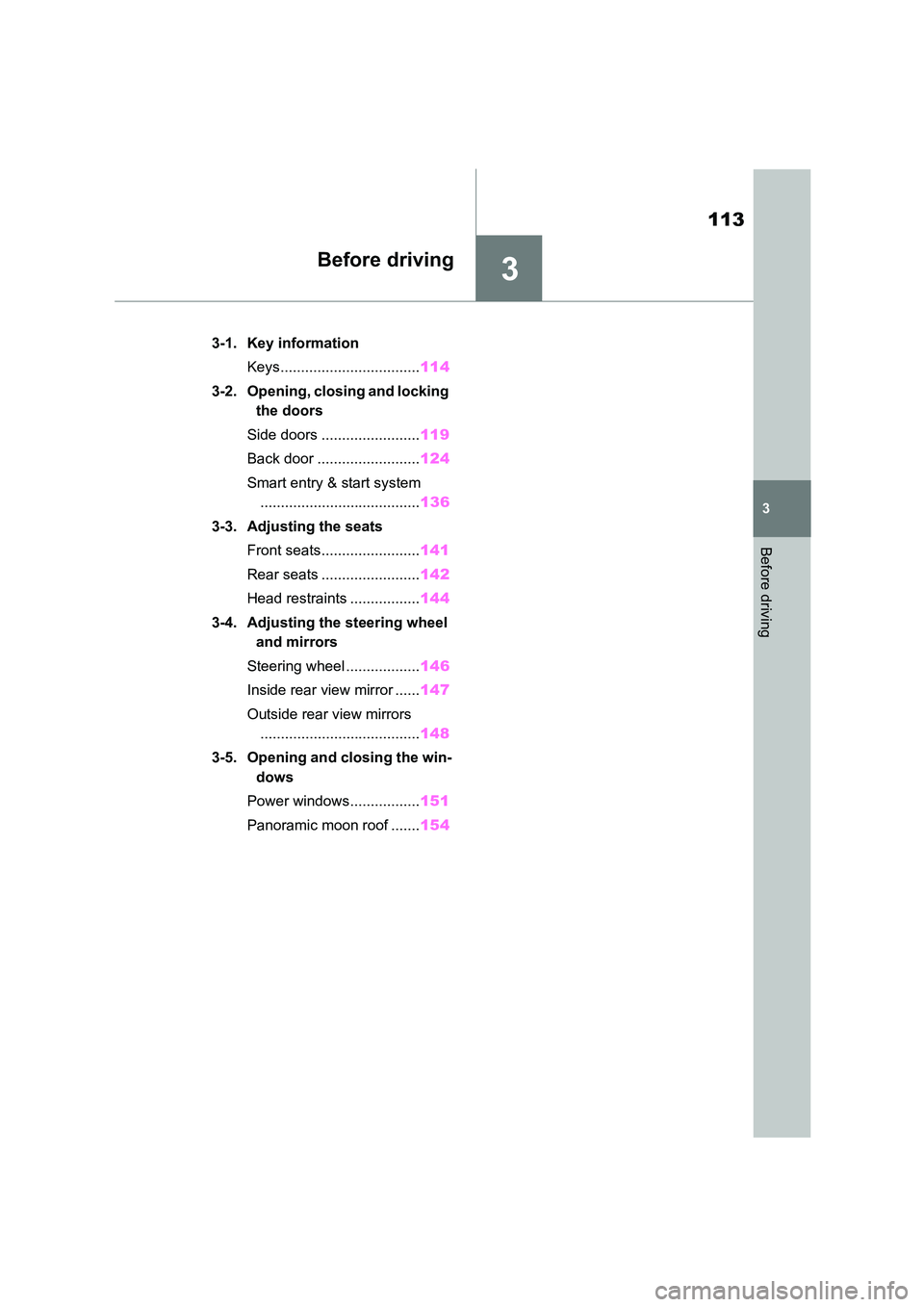
3
113
3
Before driving
Before driving
.3-1. Key information
Keys.................................. 114
3-2. Opening, closing and locking
the doors
Side doors ........................ 119
Back door ......................... 124
Smart entry & start system
....................................... 136
3-3. Adjusting the seats
Front seats........................ 141
Rear seats ........................ 142
Head restraints ................. 144
3-4. Adjusting the steering wheel
and mirrors
Steering wheel .................. 146
Inside rear view mirror ...... 147
Outside rear view mirrors
....................................... 148
3-5. Opening and closing the win-
dows
Power windows................. 151
Panoramic moon roof ....... 154
Page 116 of 758
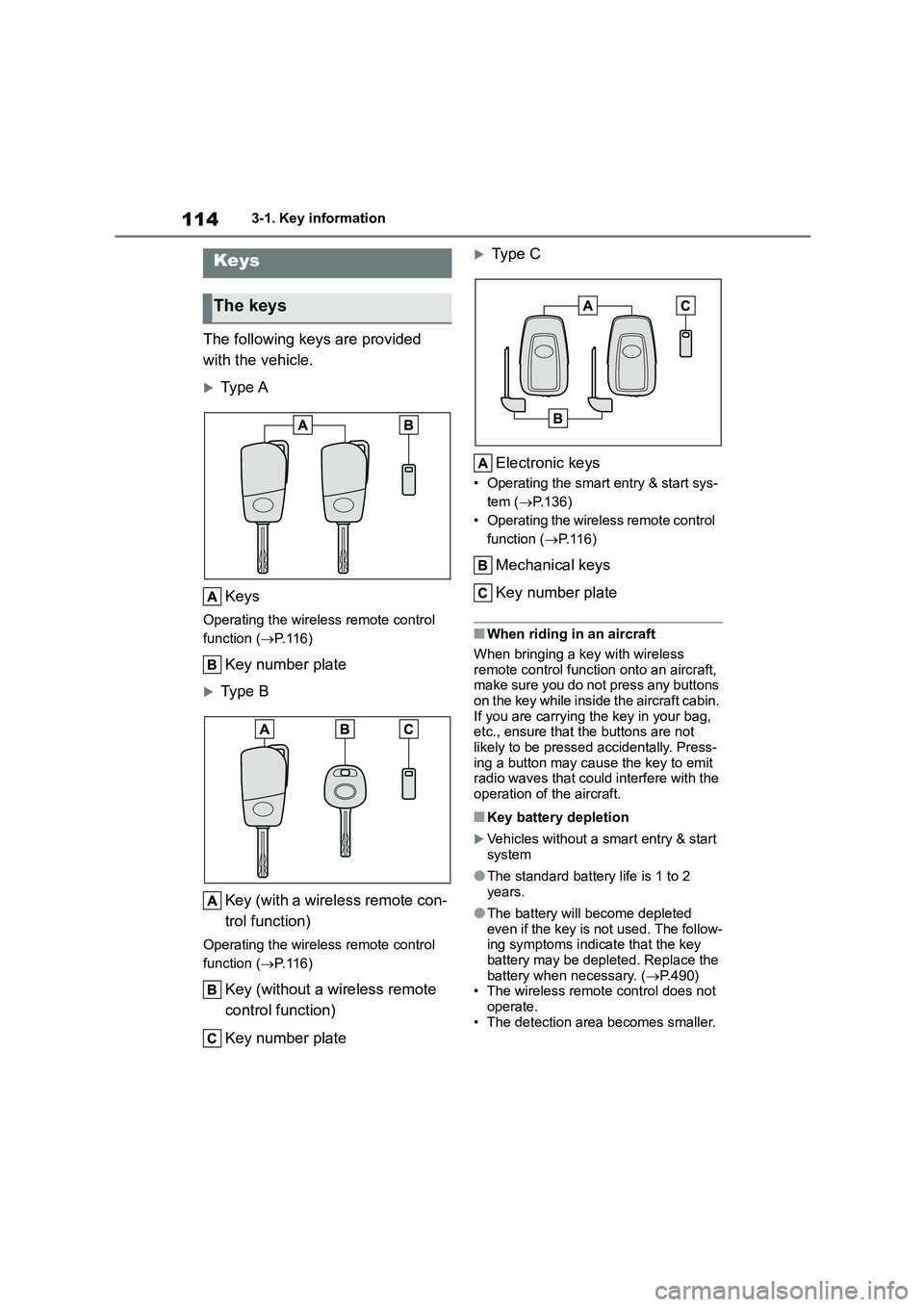
1143-1. Key information
3-1.Key information
The following keys are provided
with the vehicle.
’üĄType A
Keys
Operating the wireless remote control
function ( ’é«P.116)
Key number plate
’üĄType B
Key (with a wireless remote con-
trol function)
Operating the wireless remote control
function ( ’é«P.116)
Key (without a wireless remote
control function)
Key number plate
’üĄTy p e C
Electronic keys
ŌĆó Operating the smart entry & start sys-
tem ( ’é«P.136)
ŌĆó Operating the wire less remote control
function ( ’é«P. 1 1 6 )
Mechanical keys
Key number plate
Ō¢ĀWhen riding in an aircraft
When bringing a key with wireless remote control function onto an aircraft,
make sure you do not press any buttons
on the key while inside the aircraft cabin. If you are carrying the key in your bag,
etc., ensure that the buttons are not
likely to be pressed accidentally. Press- ing a button may cause the key to emit
radio waves that could interfere with the
operation of the aircraft.
Ō¢ĀKey battery depletion
’üĄVehicles without a smart entry & start
system
ŌŚÅThe standard battery life is 1 to 2
years.
ŌŚÅThe battery will become depleted
even if the key is not used. The follow- ing symptoms indicate that the key
battery may be depleted. Replace the
battery when necessary. ( ’é«P.490)
ŌĆó The wireless remote control does not operate.
ŌĆó The detection area becomes smaller.
Keys
The keys
Page 117 of 758
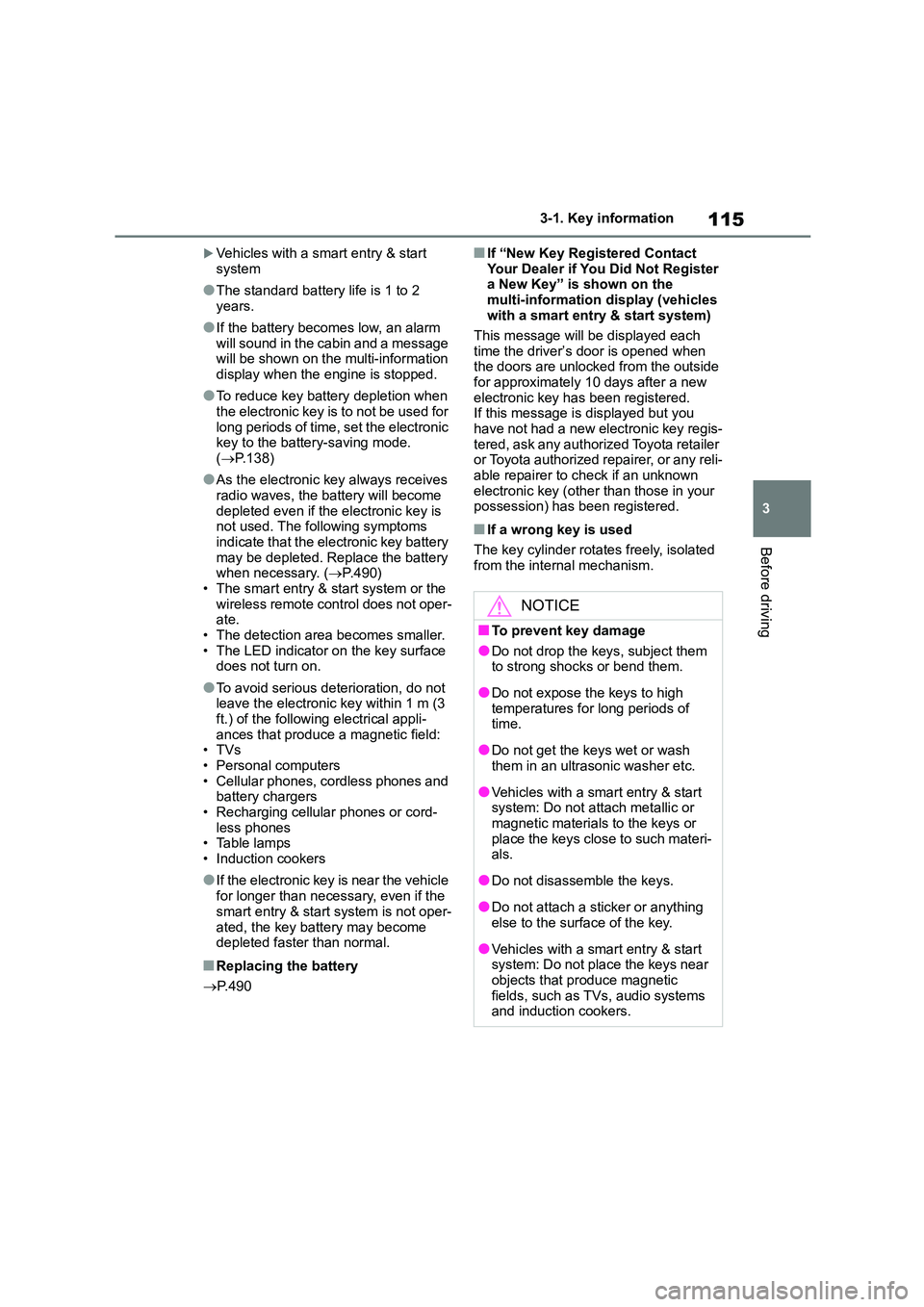
115
3
3-1. Key information
Before driving
’üĄVehicles with a smart entry & start
system
ŌŚÅThe standard battery life is 1 to 2
years.
ŌŚÅIf the battery becomes low, an alarm
will sound in the cabin and a message will be shown on the multi-information
display when the engine is stopped.
ŌŚÅTo reduce key battery depletion when
the electronic key is to not be used for
long periods of time, set the electronic key to the batter y-saving mode.
( ’é«P.138)
ŌŚÅAs the electronic key always receives
radio waves, the battery will become
depleted even if the electronic key is not used. The following symptoms
indicate that the electronic key battery
may be depleted. Replace the battery when necessary. ( ’é«P.490)
ŌĆó The smart entry & start system or the
wireless remote control does not oper- ate.
ŌĆó The detection area becomes smaller.
ŌĆó The LED indicator on the key surface does not turn on.
ŌŚÅTo avoid serious deterioration, do not leave the electronic key within 1 m (3
ft.) of the following electrical appli-
ances that produce a magnetic field: ŌĆóTVs
ŌĆó Personal computers
ŌĆó Cellular phones, cordless phones and battery chargers
ŌĆó Recharging cellular phones or cord-
less phones ŌĆó Table lamps
ŌĆó Induction cookers
ŌŚÅIf the electronic key is near the vehicle
for longer than necessary, even if the
smart entry & start system is not oper-
ated, the key battery may become depleted faster than normal.
Ō¢ĀReplacing the battery
’é« P.490
Ō¢ĀIf ŌĆ£New Key Registered Contact
Your Dealer if You Did Not Register a New KeyŌĆØ is shown on the
multi-information display (vehicles
with a smart entry & start system)
This message will be displayed each
time the driverŌĆÖs door is opened when
the doors are unlocked from the outside for approximately 10 days after a new
electronic key has been registered.
If this message is displayed but you have not had a new electronic key regis-
tered, ask any authorized Toyota retailer
or Toyota authorized repairer, or any reli- able repairer to check if an unknown
electronic key (other than those in your
possession) has been registered.
Ō¢ĀIf a wrong key is used
The key cylinder rotates freely, isolated
from the internal mechanism.
NOTICE
Ō¢ĀTo prevent key damage
ŌŚÅDo not drop the keys, subject them to strong shocks or bend them.
ŌŚÅDo not expose the keys to high temperatures for long periods of
time.
ŌŚÅDo not get the keys wet or wash
them in an ultrasonic washer etc.
ŌŚÅVehicles with a smart entry & start
system: Do not attach metallic or
magnetic materials to the keys or place the keys close to such materi-
als.
ŌŚÅDo not disassemble the keys.
ŌŚÅDo not attach a sticker or anything else to the surface of the key.
ŌŚÅVehicles with a smart entry & start system: Do not place the keys near
objects that produce magnetic
fields, such as TVs, audio systems and induction cookers.
Page 118 of 758
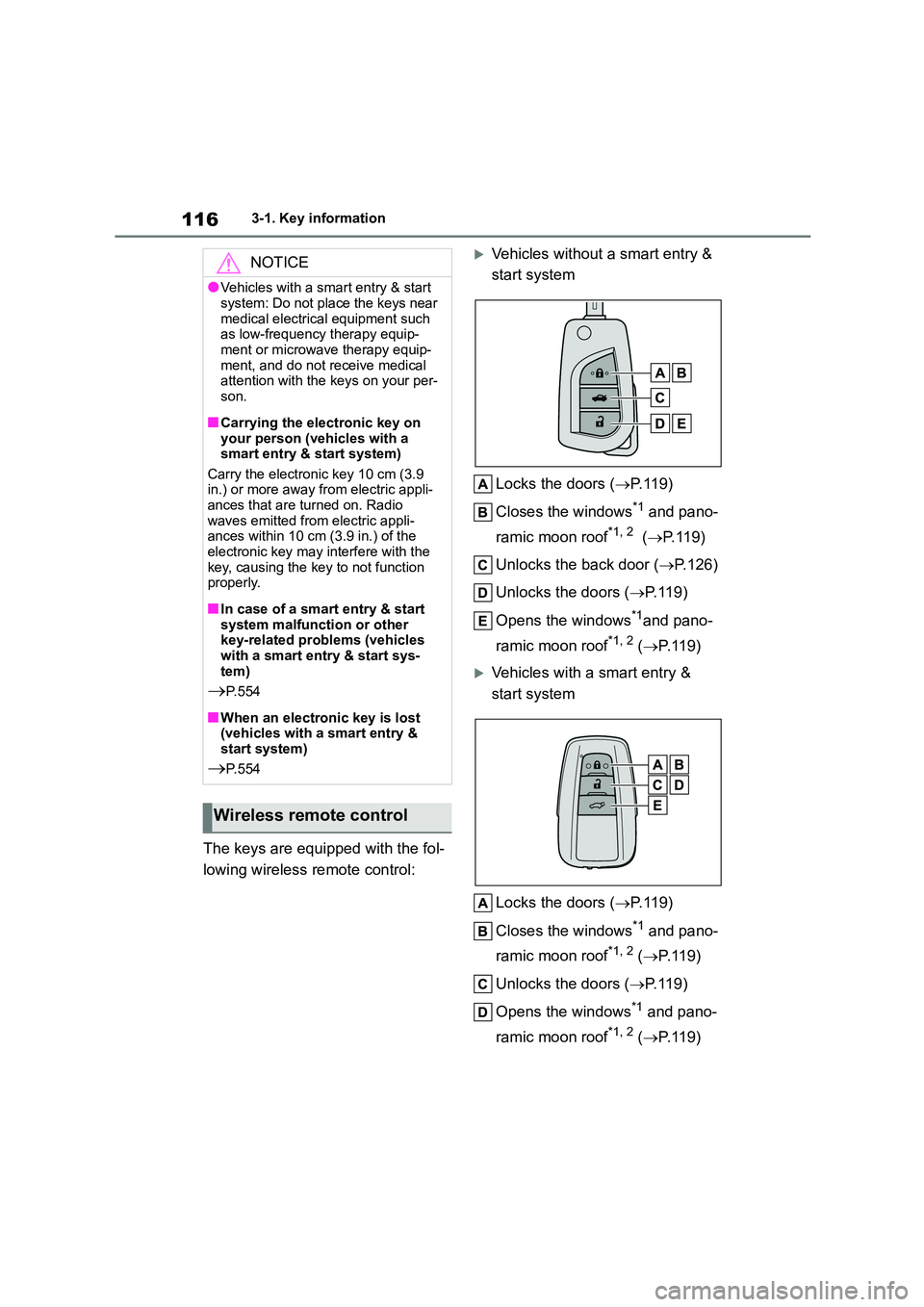
1163-1. Key information
The keys are equipped with the fol-
lowing wireless remote control:
’üĄVehicles without a smart entry &
start system
Locks the doors ( ’é«P. 1 1 9 )
Closes the windows*1 and pano-
ramic moon roof*1, 2 ( ’é«P. 1 1 9 )
Unlocks the back door ( ’é«P.126)
Unlocks the doors ( ’é«P. 1 1 9 )
Opens the windows*1and pano-
ramic moon roof*1, 2 ( ’é«P. 1 1 9 )
’üĄVehicles with a smart entry &
start system
Locks the doors ( ’é«P. 1 1 9 )
Closes the windows*1 and pano-
ramic moon roof*1, 2 ( ’é«P. 1 1 9 )
Unlocks the doors ( ’é«P. 1 1 9 )
Opens the windows*1 and pano-
ramic moon roof*1, 2 ( ’é«P. 1 1 9 )
NOTICE
ŌŚÅVehicles with a smart entry & start
system: Do not place the keys near
medical electrical equipment such as low-frequency therapy equip-
ment or microwave therapy equip-
ment, and do not receive medical attention with the keys on your per-
son.
Ō¢ĀCarrying the electronic key on your person (vehicles with a
smart entry & start system)
Carry the electronic key 10 cm (3.9 in.) or more away from electric appli-
ances that are turned on. Radio
waves emitted from electric appli- ances within 10 cm (3.9 in.) of the
electronic key may interfere with the
key, causing the key to not function properly.
Ō¢ĀIn case of a smart entry & start system malfunction or other
key-related problems (vehicles
with a smart entry & start sys- tem)
’é«P. 5 5 4
Ō¢ĀWhen an electronic key is lost
(vehicles with a smart entry &
start system)
’é«P. 5 5 4
Wireless remote control
Page 119 of 758
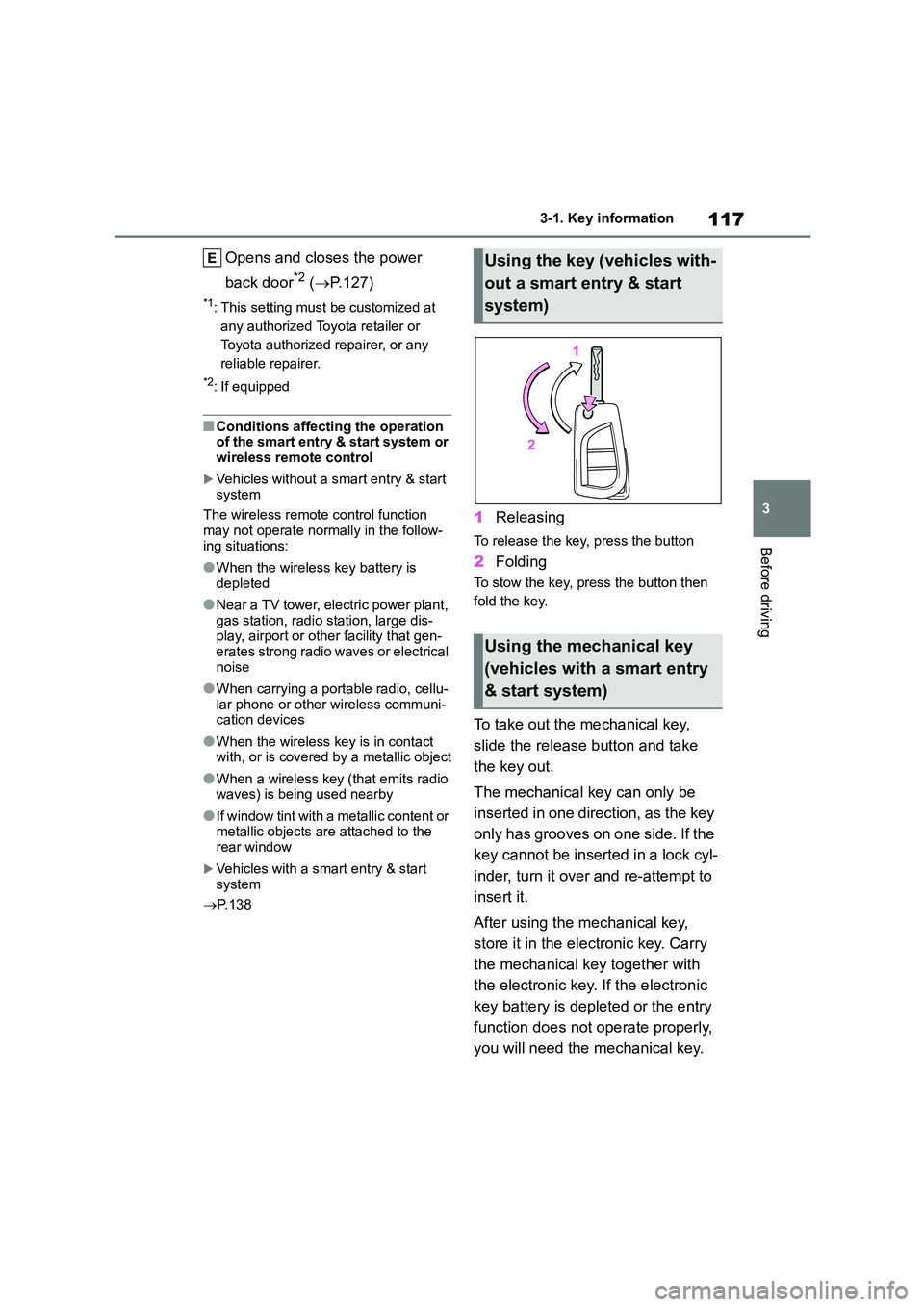
117
3
3-1. Key information
Before driving
Opens and closes the power
back door*2 ( ’é«P.127)
*1: This setting must be customized at
any authorized Toyota retailer or
Toyota authorized repairer, or any
reliable repairer.
*2: If equipped
Ō¢ĀConditions affecting the operation
of the smart entry & start system or
wireless remote control
’üĄVehicles without a smart entry & start
system
The wireless remote control function
may not operate normally in the follow-
ing situations:
ŌŚÅWhen the wireless key battery is
depleted
ŌŚÅNear a TV tower, electric power plant,
gas station, radio station, large dis- play, airport or other facility that gen-
erates strong radio waves or electrical
noise
ŌŚÅWhen carrying a portable radio, cellu-
lar phone or other wireless communi- cation devices
ŌŚÅWhen the wireless key is in contact with, or is covered by a metallic object
ŌŚÅWhen a wireless key (that emits radio
waves) is being used nearby
ŌŚÅIf window tint with a metallic content or
metallic objects are attached to the rear window
’üĄVehicles with a smart entry & start system
’é« P.138
1Releasing
To release the key, press the button
2Folding
To stow the key, press the button then
fold the key.
To take out the mechanical key,
slide the release button and take
the key out.
The mechanical key can only be
inserted in one direction, as the key
only has grooves on one side. If the
key cannot be inserted in a lock cyl-
inder, turn it over and re-attempt to
insert it.
After using the mechanical key,
store it in the electronic key. Carry
the mechanical key together with
the electronic key. If the electronic
key battery is depleted or the entry
function does not operate properly,
you will need the mechanical key.
Using the key (vehicles with-
out a smart entry & start
system)
Using the mechanical key
(vehicles with a smart entry
& start system)
Page 120 of 758
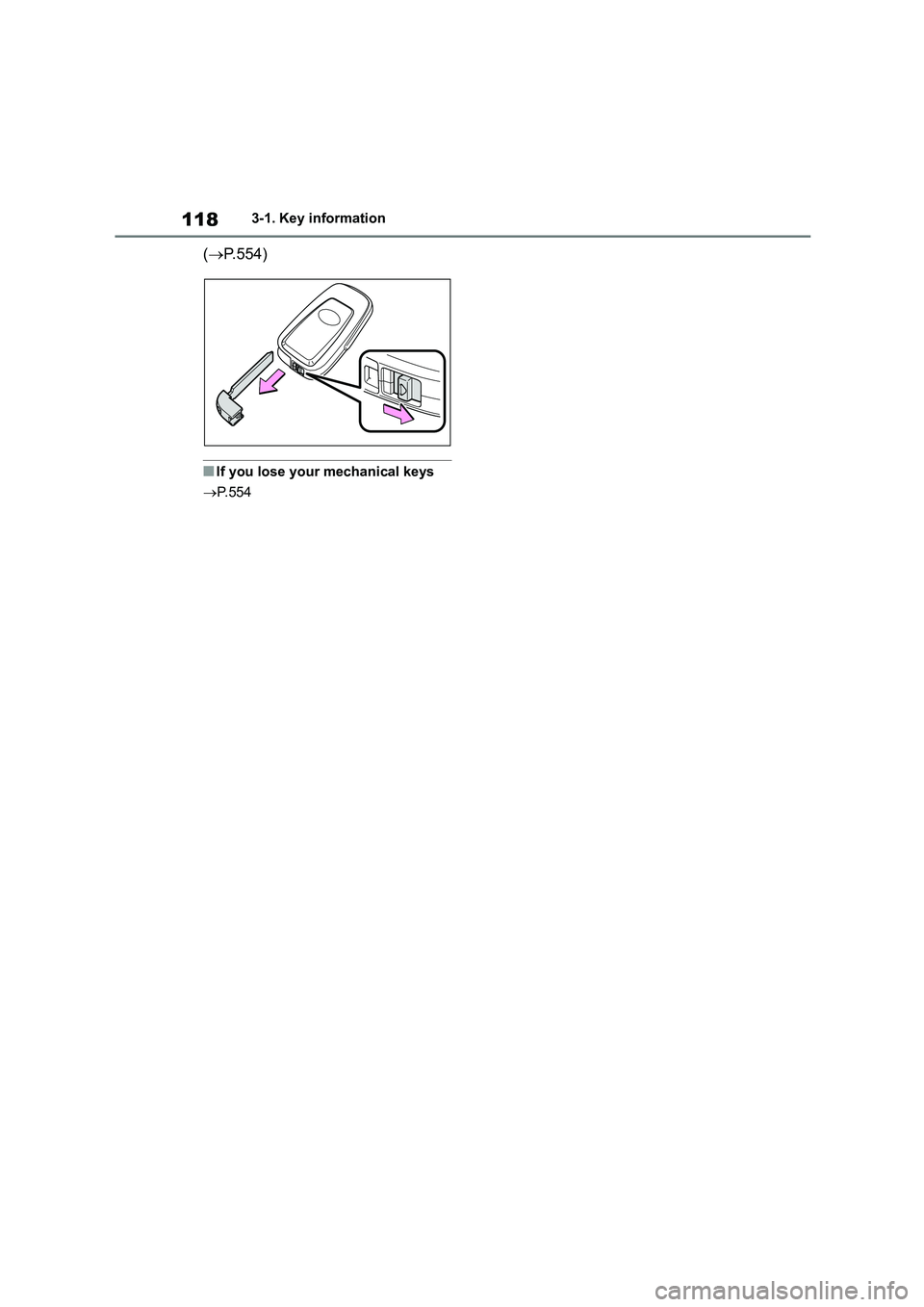
1183-1. Key information
(’é« P.554)
Ō¢ĀIf you lose your mechanical keys
’é« P.554